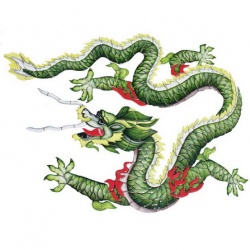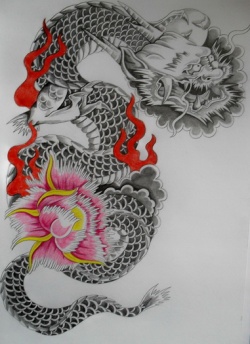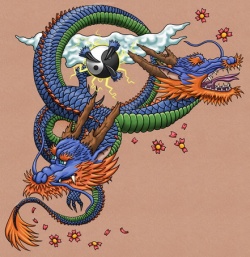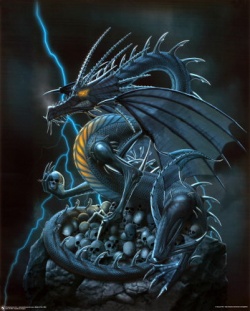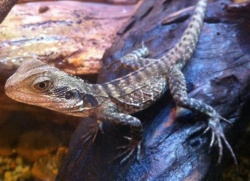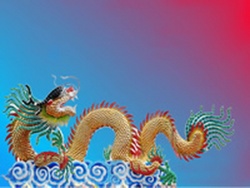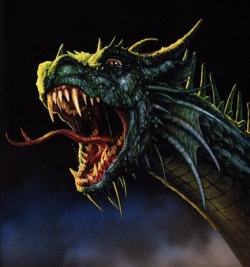Japanese dragon
<poem>
Japanese dragons (日本の竜 Nihon no ryū) are diverse legendary creatures in Japanese mythology and folklore. Japanese dragon myths amalgamate native legends with imported stories about dragons from China, Korea and India. The style of the dragon was heavily influenced by the Chinese dragon. Like these other Asian dragons, most Japanese ones are water deities associated with rainfall and bodies of water, and are typically depicted as large, wingless, serpentine creatures with clawed feet. The modern Japanese language has numerous "dragon" words, including indigenous tatsu from Old Japanese ta-tu, Sino-Japanese ryū or ryō 竜 from Chinese lóng 龍, nāga ナーガ from Sanskrit nāga, and doragon ドラゴン from English "dragon".
Indigenous Japanese dragons
The ca. 680 CE Kojiki and the ca. 720 CE Nihongi mytho-histories have the first Japanese textual references to dragons. "In the oldest annals the dragons are mentioned in various ways," explains de Visser (1913:135), "but mostly as water-gods, serpent- or dragon-shaped." The Kojiki and Nihongi mention several ancient dragons:
- Yamata no Orochi 八岐大蛇 "8-branched giant snake" was an 8-headed and 8-tailed dragon slain by the god of wind and sea Susanoo, who discovered the Kusanagi-no-Tsurugi (legendary sword of the Imperial Regalia of Japan) in one of its tails.
- Watatsumi 海神 "sea god" or Ryūjin 龍神 "dragon god" was the ruler of seas and oceans, and described as a dragon capable of changing into human form. He lived in the undersea Ryūgū-jō 龍宮城 "dragon palace castle", where he kept the magical tide jewels.
- Toyotama-hime 豊玉姫 "Luminous Pearl Princess" was Ryūjin's daughter. She purportedly was an ancestress of Emperor Jimmu, Japan's legendary first emperor.
- Wani 鰐 was a sea monster that is translated as both "shark" and "crocodile". Kuma-wani 熊鰐 "bear (i.e., giant or strong) shark/crocodile" are mentioned in two ancient legends. One says the sea god Kotoshiro-nushi-no-kami transformed into an "8-fathom kuma-wani" and fathered Toyotama-hime, the other says a kuma-wani piloted the ships of Emperor Chūai and his Empress Jingū.
- Mizuchi 蛟 or 虯 was a river dragon and water deity. The Nihongi records legendary Emperor Nintoku offering human sacrifices to mizuchi angered by his river engineering projects.
These myths about Emperor Jimmu descending from Toyatama-hime evidence the folklore that Japanese Emperors are descendants of dragons. Compare the ancient Chinese tradition of dragons symbolizing the Emperor of China.
Dragons in later Japanese folklore were influenced by Chinese and Indian myths.
- Kiyohime 清姫 "Purity Princess" was a teahouse waitress who fell in love with a young Buddhist priest. After he spurned her, she studied magic, transformed into a dragon, and killed him.
- Nure-onna 濡女 "Wet Woman" was a dragon with a snake's body and a woman's head. She was typically seen while washing her hair on a riverbank and would sometimes kill humans when angered.
- Zennyo Ryūō 善如龍王 "goodness-like dragon king" was a rain-god depicted either as a dragon with a snake on its head or as a human with a snake's tail.
- In My Lord Bag of Rice, the Ryūō "dragon king" of Lake Biwa asks the hero Tawara Tōda 田原藤太 to kill a giant centipede.
- Urashima Tarō rescued a turtle which took him to Ryūgū-jō and turned into the attractive daughter of the ocean god Ryūjin.
- Inari, the god of fertility and agriculture, was sometimes depicted as a dragon or snake instead of a fox.
Sino-Japanese dragons
Chinese dragon mythology is central to Japanese dragons. Japanese words for "dragon" are written with kanji "Chinese characters", either simplified shinjitai 竜 or traditional kyūjitai 龍 from Chinese long 龍. These kanji can be read tatsu in native Japanese kun'yomi and ryū or ryō in Sino-Japanese on'yomi.
Many Japanese dragon names are loanwords from Chinese. For instance, the Japanese counterparts of the astrological Four Symbols are:
- Seiryū - Qinglong 青龍 "Azure Dragon"
- Suzaku - Zhuque 朱雀 "Vermilion Bird"
- Byakko - Baihu 白虎 "White Tiger"
- Genbu - Xuanwu 玄武 "Black Tortoise"
Japanese Shiryū 四竜 "4 dragon (kings)" are the legendary Chinese Longwang 龍王 "Dragon Kings" who rule the four seas.
- Gōkō - Aoguang 敖廣 "Dragon King of the East Sea"
- Gōkin - Aoqin 敖欽 "Dragon King of the South Sea"
- Gōjun - Aorun 敖閏 "Dragon King of the West Sea"
- Gōjun - Aoshun 敖順 "Dragon King of the North Sea"
Some authors differentiate Japanese ryū and Chinese long dragons by the number of claws on their feet. "In Japan," writes Gould (1896:248), "it is invariably figured as possessing three claws, whereas in China it has four or five, according as it is an ordinary or an Imperial emblem."
During World War II, the Japanese military named many armaments after Chinese dragons. The Kōryū 蛟竜 - jiaolong 蛟龍 "flood dragon" was a midget submarine and the Shinryū 神竜 - shenlong 神龍 "spirit dragon" was a rocket kamikaze aircraft. An Imperial Japanese Army division, the 56th Division, was codenamed the Dragon Division. Ironically, the Dragon Division was annihilated in the Chinese town of Longling (龍陵), whose name means "Dragon's Tomb".
Indo-Japanese dragons
When Buddhist monks from other parts of Asia brought their faith to Japan they transmitted dragon and snake legends from Buddhist and Hindu mythology. The most notable examples are the nāga ナーガ or 龍 "Nāga; rain deity; protector of Buddhism" and the nāgarāja ナーガラージャ or 龍王 ”Nāgaraja; snake king; dragon king". De Visser (1913:179) notes that many Japanese nāga legends have Chinese features. "This is quite clear, for it was via China that all the Indian tales came to Japan. Moreover, many originally Japanese dragons, to which Chinese legends were applied, were afterwards identified with nāga, so that a blending of ideas was the result." For instance, the undersea palace where nāga kings supposedly live is called Japanese ryūgū 龍宮 "dragon palace" from Chinese longgong 龍宮. Compare ryūgū-jō 龍宮城 "dragon palace castle", which was the sea-god Ryūjin's undersea residence. Japanese legends about the sea-god's tide jewels, which controlled the ebb and flow of tides, have parallels in Indian legends about the nāga's nyoi-ju 如意珠 "cintamani; wish-fulfilling jewels".
Some additional examples of Buddhistic Japanese dragons are:
- Hachidai ryūō 八大龍王 "8 great naga kings" assembled to hear the Buddha expound on the Lotus Sutra, and are a common artistic motif.
- Mucharinda ムチャリンダ "Mucalinda" was the Nāga king who protected the Buddha when he achieved bodhi, and is frequently represented as a giant cobra.
- Benzaiten 弁才天 is the Japanese name of the goddess Saraswati, who killed a 3-headed Vritra serpent or dragon in the Rigveda. According to the Enoshima Engi, Benzaiten created Enoshima Island in 552 CE in order to thwart a 5-headed dragon that had been harassing people.
- Kuzuryū 九頭龍 "9-headed dragon", deriving from the multi-headed Naga king シェーシャ or 舍沙 "Shesha", is worshipped at Togakushi Shrine in Nagano Prefecture.
Dragon temples
Dragon lore is traditionally associated with Buddhist temples. Myths about dragons living in ponds and lakes near temples are widespread. De Visser (1913:181-184) lists accounts for Shitennō-ji in Osaka, Gogen Temple in Hakone, Kanagawa, and the shrine on Mount Haku where the Genpei Jōsuiki records that a Zen priest saw a 9-headed dragon transform into the goddess Kannon. In the present day, the Lake Saiko Dragon Shrine at Fujiyoshida, Yamanashi has an annual festival and fireworks show.
Temple names, like Japanese toponyms, frequently involve dragons. For instance, the Rinzai sect has Tenryū-ji 天龍寺 "Heavenly Dragon Temple", Ryūtaku-ji 龍沢寺 "Dragon Swamp Temple", Ryōan-ji 竜安寺 "Dragon Peace Temple". According to legend (de Visser 1913:180), when the Hōkō-ji 法興寺 or Asuka-dera 飛鳥寺 Buddhist temple was dedicated at Nara in 596, "a purple cloud descended from the sky and covered the pagoda as well as the Buddha hall; then the cloud became five-coloured and assumed the shape of a dragon or phoenix".
The Kinryū-no-Mai "Golden Dragon Dance" is an annual Japanese dragon dance performed at Sensō-ji, a Buddhist temple in Asakusa. The dragon dancers twist and turn within the temple grounds and outside on the streets. According to legend, the Sensō Temple was founded in 628 after two fishermen found a gold statuette of Kannon in the Sumida River, at which time golden dragons purportedly ascended into heaven. The Golden Dragon Dance celebrates the temple founding and allegedly provides good fortune and prosperity.
Dragon shrines
Japanese dragons are associated with Shinto shrines as well as Buddhist temples.
Itsukushima Shrine on Miyajima or Itsukushima Island in Japan's Inland Sea was believed to be the abode of the sea-god Ryūjin's daughter. According to the Gukanshō and The Tale of Heike (Heinrich 1997:74-75), the sea-dragon empowered Emperor Antoku to ascend the throne because his father Taira no Kiyomori offered prayers at Itsukushima and declared it his ancestral shrine. When Antoku drowned himself after being defeated in the 1185 Battle of Dan-no-ura, he lost the imperial Kusanagi sword (which legendarily came from the tail of the Yamata no Orochi] dragon) back into the sea. In another version, divers found the sword, and it is said to be preserved at Atsuta Shrine. The great earthquake of 1185 was attributed to vengeful Heike spirits, specifically the dragon powers of Antoku.
Ryūjin shinkō 竜神信仰 "dragon god faith" is a form of Shinto religious belief that worships dragons as water kami. It is connected with agricultural rituals, rain prayers, and the success of fisherman. Dragons in modern culture
Dragons are a familiar motif in Japanese art and architecture, literature, and popular culture. Some alphabetically arranged examples include:
- Gosei Sentai Dairanger is a series in the Super Sentai franchise. RyuuRanger was based on a dragon and controlled a dragon-themed mecha. This mecha was adapted into Season Two of Mighty Morphin Power Rangers as an upgrade to the Red Ranger's Tyrannosaurus zord.
- The Chunichi Dragons are a professional Japanese baseball team.
- Manda is the sea-dwelling serpentine dragon guardian of the underwater Kingdom of Mu. Manda serves as one of the primary antagonists in the 1963 tokusatsu film Atragon, however appears in minor roles within the Godzilla film series.
- King Ghidorah is a three-headed golden dragon that has taken many forms in the kaiju films, specifically in the Godzilla series, where he is commonly portrayed as a rival for Godzilla.
- Dragon Ball is a 1985 manga and anime metaseries created by Akira Toriyama, which features the seven titular mystical orbs. When gathered, the Balls will summon a dragon named Shenron that will grant one wish. Once that wish is made and executed, the Dragon Balls will scatter across the planet to be found again, however are coincidentally and commonly found by the main characters and allies.
- Dragon Quest is a popular video game series which debuted in 1986. The artwork is produced by Akira Toriyama.
- Kamen Rider Ryuki (English Kamen Rider: Dragon Knight) is a show in the Kamen Rider Series.
- Long is the main antagonist of the Gekiranger Super Sentai series and is later Americanized in Power Rangers: Jungle Fury as Dai Shi and Scorch.
- Nāsu ナース is a dragon robot in the Ultraman series.
- "Ryū (龍)" or Dragon: the Old Potter's Tale is a short story by Ryūnosuke Akutagawa
- The 2000 Capcom video game Breath of Fire IV features a tale of Ryu and Fou-Lu possessing the ability to transform into ancient dragons.
- In Hayao Miyazaki's 2001 fantasy-adventure anime film Spirited Away, Haku/Kohaku is a river spirit whose true form is an albino Japanese dragon.
- Video game Legend of Dragoon 2000 portraits the dragoons who can transform using dragon orb.
- In the Dōjin soft video game series Touhou Project, a dragon is the Highest-order God of Gensokyo worshiped by all living creatures as the creator deity. Based in Perfect Memento, the dragon is said to live in the ocean, heavens, or rain and look like a serpent with hands and horns.
- In the 2010 Capcom video game Monster Hunter Portable 3rd, Amatsumagatsuchi the elder dragon of Sacred Mountain is loosely based on the Japanese dragon and possesses the ability to manipulate storms and wind.
- The Imperial Japanese Navy and later the Japan Maritime Self-Defense Force named some of their ships after dragons. Notable examples are the World War II-era aircraft carriers Hiryu and Sōryū and the modern submarines of the Sōryū class.
- The dragon is a popular figure in Yakuza tattoos.
